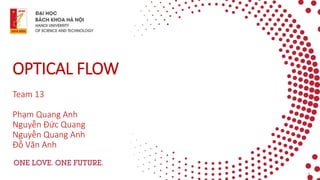
Nhóm 13-OpticalFlow.pptx
- 1. OPTICAL FLOW Team 13 Phạm Quang Anh Nguyễn Đức Quang Nguyễn Quang Anh Đỗ Văn Anh 1
- 2. Table of contents 1. Problem Definition 2. Types of Optical Flow 3. Sparse Optical Flow – Lucas-Kanade Algorithm 4. Dense Optical Flow – Horn-Schunck Algorithm 5. Conclusion 2
- 4. 1. Problem Definition • Optical Flow: Optical flow is the motion of objects between consecutive frames of sequence, caused by the relative movement between the object and camera. • Problem: Given two consecutive image frames, estimate the motion of each pixel. 4
- 7. 2. Types of Optical Flow • Sparse Optical Flow: Sparse optical flow gives the flow vectors of some "interesting features" (say few pixels depicting the edges or corners of an object) within the frame. 7
- 8. 2. Types of Optical Flow • Dense Optical Flow: Dense optical flow attempts to compute the optical flow vector for every pixel of each frame. • While such computation may be slower, it gives a more accurate result and a denser result suitable for applications such as learning structure from motion and video segmentation. 8
- 9. Sparse Optical Flow - Lucas-Kanade Algorithm 9
- 10. 3. Sparse Optical Flow – Lucas-Kanade Algorithm • Lucas and Kanade proposed an effective technique to estimate the motion of interesting features by comparing two consecutive frames. • The Lucas-Kanade method works under the brightness constancy assumption and small motion assumption. 10
- 11. 3. Sparse Optical Flow – Lucas-Kanade Algorithm • Shi-Tomashi Corner Detection: For the implementation of sparse optical flow, we only track the motion of a feature set of pixels. Features in images are points of interest which present rich image content information. 11
- 12. 3. Sparse Optical Flow – Lucas-Kanade Algorithm • Shi-Tomashi Corner Detection: 12
- 13. 3. Sparse Optical Flow – Lucas-Kanade Algorithm • Shi-Tomashi Corner Detection: 13
- 14. 3. Sparse Optical Flow – Lucas-Kanade Algorithm • Shi-Tomashi Corner Detection: 14
- 15. 3. Sparse Optical Flow – Lucas-Kanade Algorithm • Brightness constancy assumption: Brightness of the point will remain the same. I(x(t), y(t), t) = C - constant 15
- 16. 3. Sparse Optical Flow – Lucas-Kanade Algorithm • Small motion assumption: 16
- 17. 3. Sparse Optical Flow – Lucas-Kanade Algorithm • Small motion assumption: 17
- 18. 3. Sparse Optical Flow – Lucas-Kanade Algorithm 18
- 19. 3. Sparse Optical Flow – Lucas-Kanade Algorithm 19
- 20. 3. Sparse Optical Flow – Lucas-Kanade Algorithm • Aperture problem: 20
- 21. 3. Sparse Optical Flow – Lucas-Kanade Algorithm 21
- 22. 3. Sparse Optical Flow – Lucas-Kanade Algorithm • Smoothness constancy assumption: A frame portrays a “natural” scene with textured objects exhibiting shades of gray that change smoothly. 22
- 23. 3. Sparse Optical Flow – Lucas-Kanade Algorithm • Smoothness constancy assumption: 23
- 24. 3. Sparse Optical Flow – Lucas-Kanade Algorithm • Smoothness constancy assumption: 24
- 25. 3. Sparse Optical Flow – Lucas-Kanade Algorithm • Smoothness constancy assumption: 25
- 26. Dense Optical Flow - Horn-Schuck Algorithm 26
- 27. 4. Dense Optical Flow – Horn-Schunck Algorithm • The Horn–Schunck method of estimating optical flow is a global method which introduces a global constraint of smoothness to solve the aperture problem. 27
- 28. 4. Dense Optical Flow – Horn-Schunck Algorithm 28
- 29. 4. Dense Optical Flow – Horn-Schunck Algorithm 29
- 30. 4. Dense Optical Flow – Horn-Schunck Algorithm 30
- 31. 4. Dense Optical Flow – Horn-Schunck Algorithm 31
- 33. 5. Lucas Kanade with Pyramid 33 In regular optical flow method, we assume the following: • Brightness constancy • Small motion • Spatial conherence If the object were to move a larger distance →The traditional optical flow method would work bad
- 34. 5. Lucas Kanade with Pyramid 34 • Pyramid is built by using multiple copies of the same image. • Each level in the pyramid is 1/4th of the size of the previous level • The lowest level is of the highest resolution • The highest level is of the lowest resolution
- 35. 5. Lucas Kanade with Pyramid 35 • Pyramid is built by using multiple copies of the same image. • Each level in the pyramid is 1/4th of the size of the previous level • The lowest level is of the highest resolution • The highest level is of the lowest resolution • To Downsample: Using Gausian pyramid • To Upsamgple: Using Laplacian pyramid
- 36. 5. Lucas Kanade with Pyramid 36 Lucas-Kanade with Pyramid Algorithm: • Compute ‘simple’ LK optical flow at hightest level • At level i • Take flow ui-1, vi-1 from level i-1 • Bilinear interpolate it to create ui *, vi * matrices of twice resolution for level I • Multiply ui *, vi * by 2 • Warp level I Gaussian version of I2 according to predicted flow to create I2’ • Apply LK between I2’ and Gaussian version of I1 to get ui’(x, y), vi’(x, y) • Add corrections ui’ vi’ i.e. ui = ui * + vi *
- 37. THANK YOU ! 37